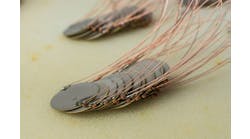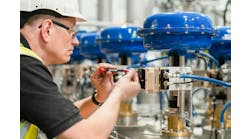Automation controls many types of mechanical motion in industrial machines. When motion control is discussed, many designers think of servos, stepper motors and linear actuators. However, the fact is, pneumatic systems provide many of the simplest options to control motion. As long as the basics of pneumatics are followed, these systems can be easily installed, and there are many benefits.
First of all, what is a pneumatic system? A pneumatic system uses compressed gasses, fluid power, to provide linear or rotary mechanical motion in a cylinder, actuator or motor, for example. A constant supply of compressed air, typically through a plant-wide distribution system, connects to a machine-mounted air-preparation unit that distributes the clean-dry air—the energy—to operate the motion causing devices.
Starting from where the motion is doing work, at the part, package or product being manufactured, there are many common machine motion functions that are ideally suited for pneumatic system operation. The pneumatic system delivers and controls energy used to clamp, crimp, press, raise, lower, open, close, extend, retract, push, rotate, divert, nip and more. Just add one of these verbs in front of the word part, package, tooling or device, and then use this verb-noun description for a PLC output that energizes a solenoid valve providing direction control of a cylinder or actuator. It's simple motion control.
The plant compressed air system includes devices that help distribute clean, dry air to each machine. Typical plant systems include a compressor, cooler, separator and receiver tank to compress, reduce compressed air temperature, remove moisture from the air and store it. However, more needs to be done at the machine level.
There are many opportunities in the compressed air distribution system for moisture and particles to enter into this closed system. As an industry best practice and a robust design, the compressed air delivered to a machine must connect to an air preparation system to ensure clean, dry air.
There are many parts to this air preparation unit which is often called an FRL because it contains a filter and regulator, and a lubricator may be used in special circumstances, such as when the pneumatic motor in an air tool needs lubricated air.
Other best-practice parts of the air preparation unit include a lockable manual shutoff valve, and an electrically operated air dump/soft-start valve; all of which are included for machine safety. Similar to an electrical disconnect switch, the manual shutoff valve protects the operator during maintenance by dumping and providing the ability of locking off the supply of compressed air to a machine. The electrically operated air dump removes motion causing pneumatic energy during an emergency stop or other similar machine safety events.
Almost all pneumatic control devices that control the energy or create the mechanical motion are located down stream of the air preparation and shutoff valves. Solenoids valves are a first stop for much of the prepped air in a pneumatic system. Individual or manifold mounted control the directional flow of air.
There are many types of directional valves and couple often used are 5-way, 3-position, center exhaust or center block valves. With these valves each direction of air is controlled by a PLC output, extend and retract, or open and close. Center exhaust is often used to ensure that motion causing air is dumped from the cylinder or actuator when an emergency stop is pressed. However, some motions may benefit from a center block configuration to hold tooling up under an emergency stop condition, but beware of the safety hazards of blocking air to a cylinder when clearing jams.
Check valves also affect the flow of air into and out of a cylinder or actuator. Instead of a center blocked valve, a pilot operated check valve could be used to hold up a cylinder during an emergency stop. Regardless of the method used, use caution when trapping air in a cylinder as unexpected motion is a possibility.
Flow controls also meter the air into or out of a cylinder. It is an important pneumatic system component used to limit the speed of a cylinder during operation by restricting air as it leaves, or depending on the application, enters a cylinder.
The primary reasons pneumatic systems are so popular in machine motion control is its simplicity—the components are easy to install—it's also one of the many advantages. A variety of fittings, flexible tubing and hoses and rigid pipes connect the solenoid valves, check valves and flow controls to cylinders, actuators, motors, grippers and air nozzles.
With just a little vendor support, any technician or maintenance personnel can specify proper air preparation units, solenoids, cylinders and actuators. With proper selection and a straight-forward pneumatic design, high reliability and durability is the likely result in a variety of harsh, industrial and even hazardous, explosive environments.
It starts air preparation and proper selection and installation of pneumatic solenoid valves, cylinders and actuators, then the simple adjustment of flow and pressure controls optimizes mechanical motions during operation. The air preparation provides clean dry air, solenoid valves control direction, cylinders and actuators do the work and flow control and pressure regulators affect cylinder speed and cylinder force. All combine to help ensure reliable and efficient machine operation.






